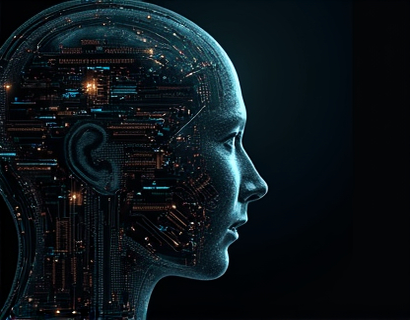AI and Crypto: Transforming Digital Engagement for Next-Gen Ecosystem Experiences
The integration of artificial intelligence (AI) and cryptocurrency is ushering in a new era of digital engagement, redefining how users interact with online ecosystems. This transformative synergy is not just a technological advancement but a paradigm shift that promises to enhance user experiences, security, and accessibility. As we delve into this topic, it's essential to understand the foundational roles of both AI and cryptocurrency in the digital landscape and how their convergence is reshaping the future of online interactions.
Understanding AI in Digital Ecosystems
Artificial intelligence, a subset of computer science, focuses on creating systems that can perform tasks requiring human intelligence, such as learning, reasoning, and self-correction. In the context of digital ecosystems, AI serves as a powerful tool for personalization, automation, and data analysis. By leveraging machine learning algorithms, AI can analyze vast amounts of user data to predict preferences, optimize content delivery, and enhance user interfaces. This capability is crucial for creating engaging and intuitive digital experiences that keep users coming back.
One of the most significant applications of AI in digital ecosystems is in user experience (UX) design. AI-driven UX design uses natural language processing (NLP) and computer vision to create interfaces that adapt to user behavior and preferences. For instance, AI can dynamically adjust the layout of a webpage based on the device being used, ensuring an optimal viewing experience across desktops, tablets, and smartphones. Additionally, AI chatbots and virtual assistants provide instant customer support, answering queries and guiding users through complex processes with minimal human intervention.
Cryptocurrency: A New Paradigm for Digital Transactions
Cryptocurrency, built on blockchain technology, represents a decentralized and secure method of conducting financial transactions. Unlike traditional currencies, cryptocurrencies are not controlled by any central authority, making them resistant to censorship and manipulation. This decentralized nature aligns well with the principles of digital ecosystems, which thrive on openness, transparency, and user empowerment. The integration of cryptocurrency into these ecosystems not only facilitates seamless transactions but also enhances trust and security among users.
Blockchain, the underlying technology of cryptocurrency, provides a tamper-proof ledger that records all transactions in a transparent and immutable manner. This ensures that user data and financial transactions are secure and verifiable, reducing the risk of fraud and enhancing user confidence. Moreover, smart contracts, self-executing contracts with the terms directly written into code, automate and enforce agreements without the need for intermediaries, further streamlining processes within digital ecosystems.
Synergy Between AI and Cryptocurrency
The combination of AI and cryptocurrency creates a powerful synergy that amplifies the benefits of both technologies. AI can enhance the security, efficiency, and user experience of cryptocurrency-based systems. For example, AI algorithms can be used to detect and prevent fraudulent activities in real-time by analyzing transaction patterns and identifying anomalies. This proactive approach to security is crucial in a space where financial transactions are conducted without traditional oversight.
Furthermore, AI can optimize the performance of blockchain networks. By predicting network congestion and adjusting consensus mechanisms dynamically, AI can ensure that transactions are processed swiftly and efficiently. This is particularly important as the adoption of cryptocurrency continues to grow, leading to increased transaction volumes and network complexity. AI-driven solutions can also improve the scalability of blockchain by developing more efficient consensus algorithms and off-chain transaction processing methods.
Enhancing User Engagement Through AI and Crypto
One of the most exciting aspects of integrating AI and cryptocurrency is the potential to revolutionize user engagement within digital ecosystems. By leveraging AI, these ecosystems can offer personalized experiences that cater to individual user preferences and behaviors. For instance, AI can analyze user interactions and tailor content recommendations, ensuring that users are presented with relevant and engaging material. This level of personalization not only increases user satisfaction but also fosters a deeper connection with the ecosystem.
Cryptocurrency adds another layer of engagement by enabling token-based incentives. Tokens can be used to reward users for participating in various activities, such as contributing content, referring friends, or completing tasks. This gamification of user engagement encourages active participation and loyalty, creating a more vibrant and interactive community. Moreover, tokens can serve as a form of digital currency within the ecosystem, allowing users to purchase goods and services, access premium features, or even vote on governance decisions.
Case Studies and Real-World Applications
Several projects and platforms are already demonstrating the potential of AI and cryptocurrency in enhancing digital engagement. One notable example is Decentraland, a virtual reality world built on the Ethereum blockchain. Decentraland uses AI to create immersive and dynamic environments that adapt to user interactions. Users can own virtual land, create and sell digital assets, and participate in community-driven governance through token voting. The integration of AI ensures that the virtual world remains engaging and responsive, while cryptocurrency provides a secure and decentralized economy.
Another example is Axie Infinity, a blockchain-based gaming platform that combines AI-driven game mechanics with cryptocurrency incentives. Players can earn Axie Infinity tokens (AXS) and Creeps tokens (CRY) by participating in gameplay, creating and trading digital creatures, and contributing to the community. AI algorithms optimize game balance and difficulty, ensuring a fair and enjoyable experience for all players. The use of cryptocurrency not only rewards players but also creates a thriving market for digital assets, further enriching the ecosystem.
Challenges and Considerations
While the integration of AI and cryptocurrency offers numerous benefits, it also presents several challenges that need to be addressed. One of the primary concerns is regulatory compliance. The cryptocurrency space is still largely unregulated, and the use of AI adds another layer of complexity. Ensuring that these systems comply with existing laws and regulations, while also advocating for favorable policies, is crucial for sustainable growth.
Another challenge is the technical hurdle of integrating AI with blockchain technology. Blockchain's inherent limitations, such as scalability and transaction speed, can be exacerbated by the computational demands of AI algorithms. Developing efficient and scalable solutions that can handle the increased load is essential for the success of these integrated systems. Additionally, ensuring the privacy and security of user data remains a top priority, as the combination of AI and cryptocurrency involves handling sensitive information.
Future Prospects and Opportunities
The future of AI and cryptocurrency in digital ecosystems is promising, with numerous opportunities for innovation and growth. As AI technology continues to advance, we can expect more sophisticated and seamless integrations that further enhance user experiences. For instance, the development of AI-powered predictive analytics can help forecast user behavior and market trends, enabling more informed decision-making within digital ecosystems.
Cryptocurrency, on the other hand, is likely to become more mainstream, with increased adoption by businesses and consumers alike. The rise of central bank digital currencies (CBDCs) and the growing acceptance of cryptocurrencies as a legitimate form of payment will further integrate these digital assets into everyday transactions. This broader acceptance will drive more projects to adopt AI and cryptocurrency, creating a virtuous cycle of innovation and adoption.
Moreover, the convergence of AI and cryptocurrency can lead to the development of new business models and revenue streams. Tokenized economies, where tokens represent ownership or utility within an ecosystem, can revolutionize how value is created and distributed. This model not only incentivizes participation but also aligns the interests of users and the ecosystem, fostering a more collaborative and sustainable environment.
Conclusion
The integration of AI and cryptocurrency is poised to transform digital engagement in profound ways, offering enhanced security, personalization, and user empowerment. As these technologies continue to evolve, we can expect to see more innovative applications that redefine the digital landscape. For tech enthusiasts and investors, this convergence presents exciting opportunities to be at the forefront of a new technological revolution. By embracing the potential of AI and cryptocurrency, we can unlock new possibilities for engagement and interaction in the digital ecosystem.











































